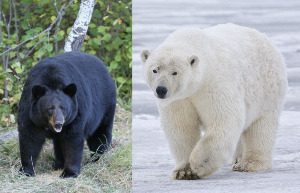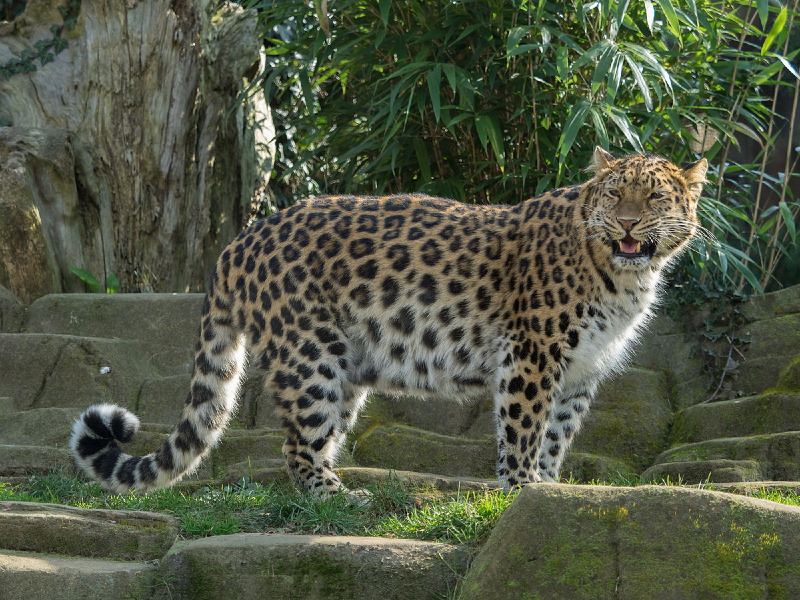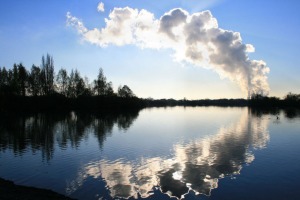|
|

by Aissata Bah, age 7
Polar bears and black bears are part of the same family, although they live in different parts of the world. Polar bears are giants that live in the Arctic Circle, while black bears live in the forests of Canada, the United States and Mexico.
Polar bears are skilled hunters. They need a lot of food to survive in the far North, so they eat a lot of meat, especially seals. They also eat beluga whales by jumping on their backs and attacking them. During the summer polar bears eat plants, small mammals, birds, and bird eggs.
[read more]

by Sol-Saray, age 9
Did you know that there are different types of leopards in the world? A really interesting one is called the Amur leopard! These leopards weigh 80 pounds, which is 30 pounds less than the African leopard. They prey on mice, bunnies, boar, and deer.
Many people think that leopards live only in the savannas of Africa, but the Amur leopard inhabits southern Russia and northern China. Its large paws allow the leopard to walk on snow without sinking, working like snowshoes.
The Amur leopard hunts for prey in snowy hillsides. They hunch so low they almost touch the snow with their bellies. Their prey is distracted while finding something to eat in the cold winter of Russia. Then, the leopard unexpectedly jumps on their prey from 10 feet away. Amur leopards often drag their prey up into trees before eating. It's time for the leopard to eat!
[read more]

by Valeria Moreno Lopez, age 12
Greenhouse gas (GHG) levels are higher now than in the last 650,000 years. This causes the Earth to heat up, changing temperatures and lifestyles for the humans that inhabit Earth.
When specific gases in Earth’s atmosphere trap the heat from the sun, it is called the “greenhouse effect” because it warms the Earth like the walls of a greenhouse. The gases let light in but keep heat trapped. Sunlight shines on the Earth’s surface, where it’s absorbed and then released back into the atmosphere as heat. Greenhouse gases trap some of this heat, and then the rest goes into space. As Earth spins every day, new heat comes onto the surface, evaporating moisture from the oceans and scattering it around the world because of changing weather patterns. People have known about the greenhouse effect since 1824. The effect is what is keeping the climate of the world livable, and without it, Earth’s surface would be about 60 degrees Fahrenheit (15 degrees Celsius) cooler.
[read more]
Polar bears and black bears are part of the same family, although they live in different parts of the world. Polar bears are giants that live in the Arctic Circle, while black bears live in the forests of Canada, the United States and Mexico.
[read more...]
A tornado is a type of storm that has the shape of an upside-down cone. It is made up of clouds and air that rotates from the center of the storm in the sky down to the ground.
[read more...]
Greenhouse gas (GHG) levels are higher now than in the last 650,000 years. This causes the Earth to heat up, changing temperatures and lifestyles for the humans that inhabit Earth.
[read more...]
Wisconsin is known for many things including dairy and fishing. Walleye is a favorite fish of tourists to Wisconsin, but unfortunately these sought-after fish are currently at risk.
[read more...]
The oceans are vast bodies of water holding many secrets. Submarines cannot handle all of the pressure in the oceans, so while we know some facts about them, there remains much to learn.
[read more...]
Did you know that there are many levels of endangered species, not just one? Being “endangered” means the population of a species is becoming dangerously low.
[read more...]
Did you know the Bengal tiger loves water the most out of all the big cats? It uses this feature to its advantage in the tropical climate of northeastern India and Bangladesh. While the Bengal tiger uses the water to bathe or cool off, they also use it to find prey.
[read more...]
Pollution is a bad thing for the world. There are many types of pollution including water and air pollution. Water pollution can involve putting trash and chemicals into the water, whereas air pollution can involve the air becoming so thick that you might even see it or have problems breathing.
[read more...]
Have you heard of the famous meat-eating plant? It’s called the Venus flytrap.
Insects are attracted to the Venus flytrap for several reasons. The unique shape of its leaves appears inviting and safe. It also offers nectar. As soon as an insect nears the plant, its quick leaves spring to life.
[read more...]
The word tsunami is Japanese for "great harbor waves." Tsunamis are a powerful force of destruction.
[read more...]
The Arctic Ocean is home to a diverse collection of animals including belugas, walruses, narwhals, and jellyfish.
[read more...]
Clown fish are at risk of being endangered. Clown fish live in sea anemones that grow on coral reefs. Because of climate change, scientists fear that coral reefs will die and the clown fish won’t have a place to live.
[read more...]
Blue Spruce Farm in Bridport, Vermont can now make electricity from cow manure.
[read more...]
The dinosaurs’ digestive system could have been what made the Earth warmer. About 200 million years ago, during the Mesozoic Era, the world was 18 degrees warmer than it is now. The plant-eating dinosaurs’ digestive systems produced methane gas through burps and passing gas.
[read more...]
Forest fires can be bad, but they also can be good. For many years people thought that all forest fires should be put out. Then they realized stopping the small fires made big fires worse.
[read more...]
Some pollutants can actually be useful to people in some places, even though they are harmful in other places. For example, ozone is a gas that is important in the high atmosphere, but harmful in the low atmosphere where it becomes a pollutant. Down on Earth, ozone is a major ingredient in smog and is dangerous to living things, including people. Ozone is made when oxygen interacts with sunlight high in the atmosphere. Yet, we need ozone in the high atmosphere because it keeps the Sun’s harmful rays away from our skin. When ozone disappears, more of the rays reach the Earth, damaging plants and causing more sunburns and skin cancer in people.
[read more...]
Many people wonder why every state has a national park except Delaware. Luckily for them, there’s a proposal being discussed concerning a national park to be added in Delaware.
[read more...]
British Petroleum, or BP has tried a number of methods to permanently stop the oil spill in the Gulf.
[read more...]
Do you know how the recent oil spill in the Gulf of Mexico started?
[read more...]
Lots of people are trying to clean up the oil spill in the Gulf. One way they are doing this is by adding chemicals to the water that separate the oil into smaller pieces. Then natural microbes like bacteria can help break down the oil more easily. But those chemicals can be dangerous to fish and other wildlife and can also cause drops of oil to spread more quickly. Scientists have already discovered clouds of oil at the bottom of the gulf that have been created by dispersants. They are afraid that the oil will kill tiny creatures at the bottom of the Gulf that larger animals depend on for food.
[read more...]
Even though the oil spill has had a lot of negative consequences, there are things kids and adults can do to help.
[read more...]
Oil causes a lot of damage when it reaches the coastline, especially in an area as fragile as the Gulf Coast. The Gulf Coast is lined with natural areas such as marshes, swamps, forests and islands that are home to rare species of birds, fish, and other wildlife. Area wetlands also provide coastal areas with protection from hurricanes.
[read more...]
Earthquakes could first be detected a long time ago in 130 AD. That’s when a Chinese astronomer invented an instrument, that is now called a seismometer, to detect them.first paragraph
[read more...]
Would you like to put some extra money in your pocket? If you do, driving a hybrid electric vehicle (HEV) would probably help.
[read more...]
|
|

